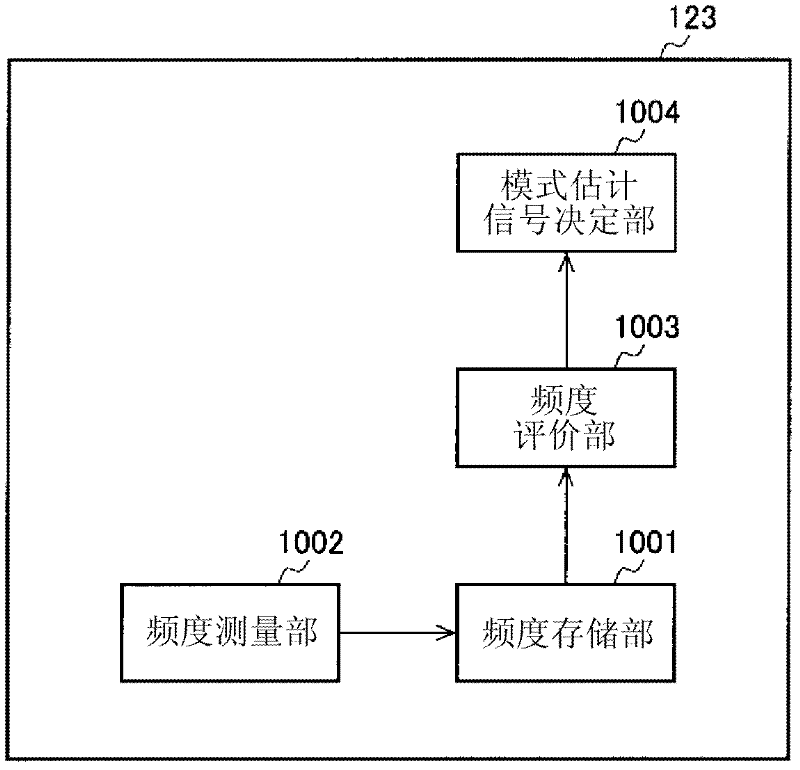Image encoding device and image decoding device
An image encoding and image decoding technology, applied in the field of image decoding devices, can solve the problems of high computing load, reduced encoding efficiency, low encoding efficiency, etc., and achieve the effect of reducing the amount of code and improving the encoding efficiency
- Summary
- Abstract
- Description
- Claims
- Application Information
AI Technical Summary
Problems solved by technology
Method used
Image
Examples
Embodiment approach 1
[0083] In Embodiment 1, the case where a scanning mode is selected and coded is demonstrated. In this case, the transform method and the quantization method are predetermined.
[0084] (Configuration of Image Coding Device 100 )
[0085] figure 1 It is a block diagram showing the configuration of the image coding device 100 according to Embodiment 1 of the present invention. exist figure 1 Among them, the image coding device 100 includes a prediction unit 111, a transformation unit 112, a quantization unit 113, a scanning unit 114, a variable length coding unit 115, an inverse quantization unit 116, an inverse transformation unit 117, a frame memory 118, a transformation coefficient evaluation unit 121, Mode selection unit 122 , mode estimation unit 123 , mode restriction unit 124 , subtraction unit 101 , and addition unit 102 . Reference numerals in the figure, 103 indicate the transform coefficient output from the transform unit 112, 104 indicate the quantized transform ...
Deformed example 1
[0224] (A configuration including only the mode estimation unit 123)
[0225] Figure 10 It is a flowchart for explaining the operation of the mode selection unit 122 in Modification 1 that does not include the mode restriction unit 124 but includes the mode estimation unit 123 .
[0226] The operation of the mode selection unit 122 in this case is the same as using Figure 7The described situation is basically the same, but there are differences in that there is no S1009 operation of obtaining the mode restriction signal, S1010 decision / branch operation, and S1013 operation of setting the cost so that the scanning mode is not selected.
Deformed example 2
[0228] (A configuration including only the mode restricting unit 124)
[0229] Figure 11 It is a flowchart for explaining the operation of the mode selection unit 122 in Modification 2 in which the mode estimation unit 123 is not provided but the mode restriction unit 124 is provided.
[0230] The operation of the mode selection unit 122 in this case is the same as using Figure 7 The described situation is basically the same, but there is no difference in that there is no action of obtaining the mode estimation signal in S1008.
[0231] In addition, when the number of selectable scan modes is greater than one, the mode restricting unit 124 described above uses a list of mode numbers as selectable scan modes in addition to the number of selectable scan modes. However, in the case of Modification 2, even if the number of selectable scan modes is one, the range of selectable scan modes (here, one, Hence the scan mode).
PUM
 Login to View More
Login to View More Abstract
Description
Claims
Application Information
 Login to View More
Login to View More - R&D
- Intellectual Property
- Life Sciences
- Materials
- Tech Scout
- Unparalleled Data Quality
- Higher Quality Content
- 60% Fewer Hallucinations
Browse by: Latest US Patents, China's latest patents, Technical Efficacy Thesaurus, Application Domain, Technology Topic, Popular Technical Reports.
© 2025 PatSnap. All rights reserved.Legal|Privacy policy|Modern Slavery Act Transparency Statement|Sitemap|About US| Contact US: help@patsnap.com



